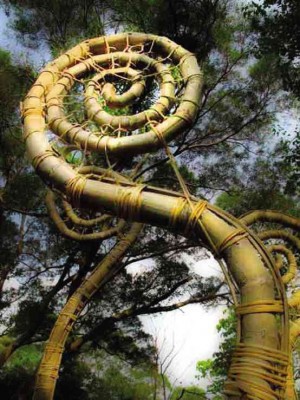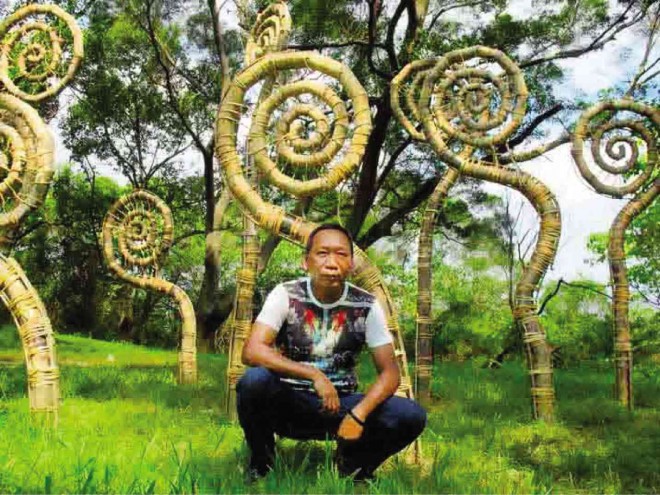More than a nature installation artist
BAGUIO CITY—Artist Rishab Tibon’s house on Asin Road at the border of Baguio and Tuba, Benguet province, is surrounded with fiddleheads, especially during the rainy season.
“Fiddleheads are fern sprouts. Before they become fully grown leafy ferns, these sprouts are curled like scrolls which are a natural shape of nature that are also found in the inner portions of shells, horns of animals, ripples and many others,” Tibon says.
The plants are so named because they resemble the scrolls or the heads of violins or fiddles. These demonstrate the golden ratio or golden proportion, a favorite theme in art, music and architecture, Tibon says.
In his dreams, the artist must have thought of recreating fiddleheads. He did as his dreamy paintings sprout with them alongside his blue tattooed nudes, winged cats and women with flower hairs.
But what he did last year on the campus of Taipei National University of the Arts (TNUA) confounded even his friends and patrons. He created 10 fiddleheads, as tall as 3 meters (10 feet), using giant bamboo and rattan strips.
Article continues after this advertisementFurniture makers would say rattan canes can be bent using steam, but for giant bamboos to curl up like fiddleheads?
Article continues after this advertisementAn illusion
“It was an illusion,” Tibon says.
With 10 student volunteers from the TNUA, Tibon sawed the bamboo tubes and glued them with epoxy. The rattan strips only created the illusion that the bamboo nodes were tied to create the inward spirals.
“I cannot find ‘U’ nails there so we have to fashion them. We worked on the fiddleheads for a month,” he says.
But when the fiddleheads were displayed at the 2014 Guandu International Outdoor Sculpture Festival at the school in September, the reaction was surprise and delight, says Tibon.
He says the giant fiddleheads were his way of saying, “Hey, there’s always time to smell the roses and fiddleheads.”

ARTIST Rishab Tibon displays his fiddleheads, nature art installations which were featured at Taipei National University of the Arts. CONTRIBUTED PHOTO
“With modern times and living hastily to catch up with our daily chores, we often have no more time to look and ponder at our surrounding, especially the smallest of things. We are preoccupied with bigger concerns, and we give more priority to these than the smaller ones, like those that are found in nature and have no direct concern to us,” he says.
Hummingbird
In the 2012 Guandu Festival in Taipei, Tibon created a huge hummingbird made of bamboo and rattan with a man riding on it. Tibon is a favorite in the Guandu Festival, where he is more known as a nature installation artist than a painter.
His first work for the event was “The Shield,” which he presented in 2008. It was a 6-meter (20-foot) dome made of bamboo and grass which people can enter into. What makes it an inquisitive piece of art are the large holes on the dome.
Tibon says this is his representation of the Earth’s ozone layer and the holes are those caused by greenhouse gases that eat up the protective shield of the planet.
His “Nurturing Memories,” presented during the 2011 Guandu Festival, is a huge bamboo gazebo with eight caged trellises as posts.
Like all of his nature installations, Tibon would work with materials on site. Having roamed the area, he would know what natural materials are available and he would work his lyrical sculpture around them.
After the festival, he would leave his compositions and let them decompose in the area. His fans would send him photos of how his nature installations became part of nature through the seasons.
His success at the Guandu Festival earned him invitations to other parts of Taiwan, as well as in South Korea.
His patrons thought that this is a different direction from the surreal paintings he is known for in the Philippines, but Tibon says he has always been doing this in Baguio since the 1990s.
His “Entrapments of the Mind” (1997) consists of huge bamboo poles with “flames” made of split bamboo. Variations of these had been shown in Baguio as well as in Taiwan.
Aklan native
Although his roots are in Aklan province, Tibon grew up in Metro Manila where his father was a known carpenter. “It was by watching and helping my father that I learned carpentry,” he says.
But his artistry with the pen was what he nurtured and he later became a draftsman for an advertising firm.
His biggest break was when he became a sparring partner of National Artist Benedicto Cabrera (BenCab) in “arnis.” He came with BenCab to Baguio, sparred with him and started to paint his dreams.
